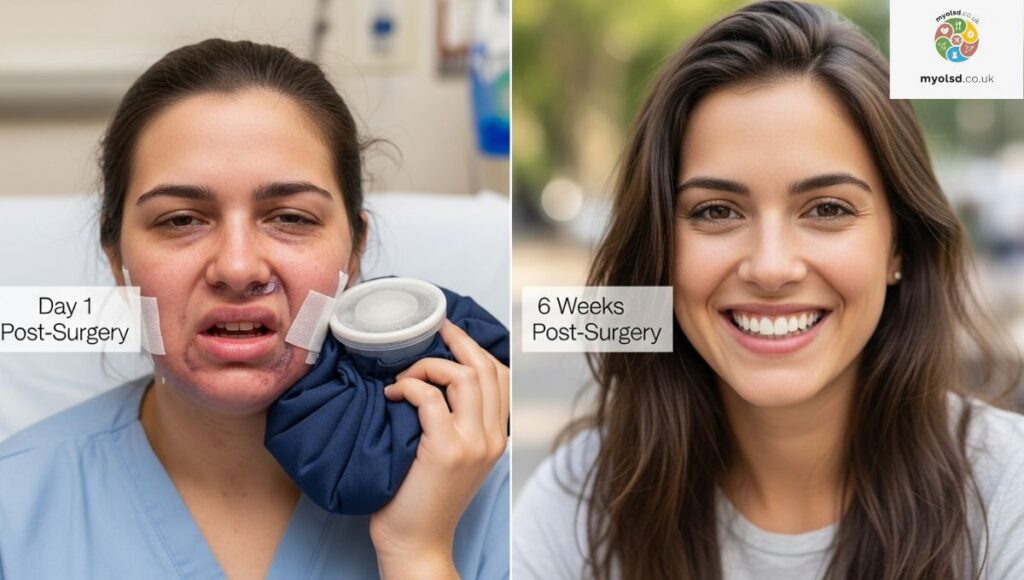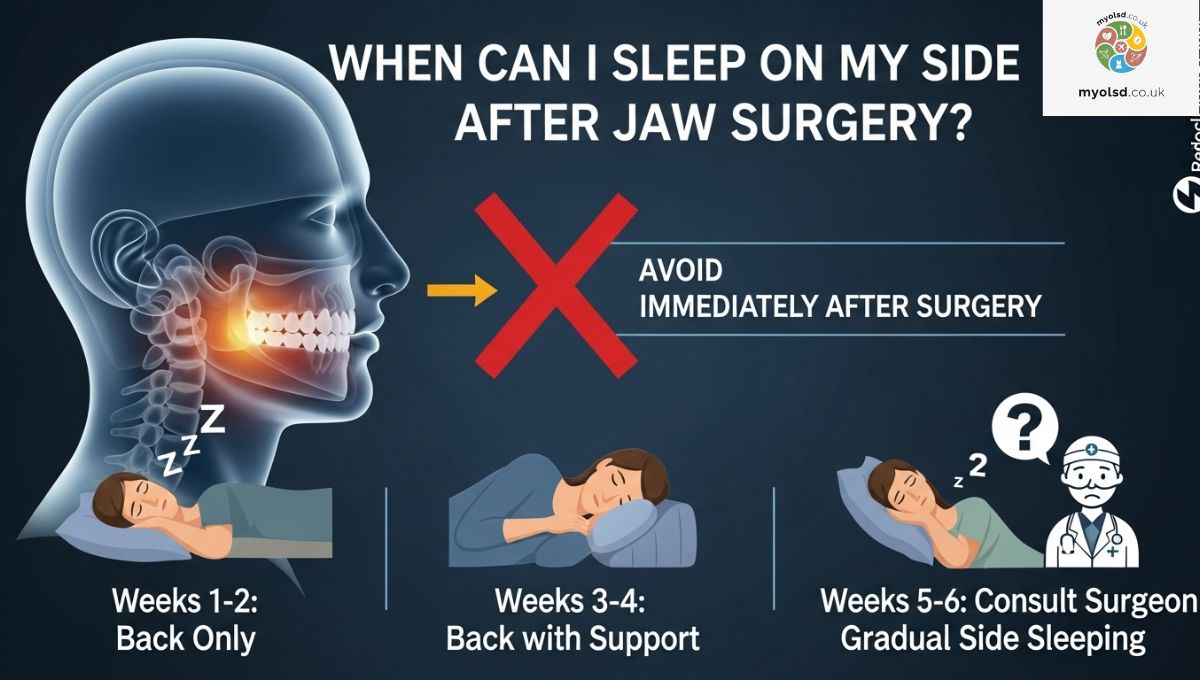If you’ve recently had jaw surgery, you probably know how hard it is to find a comfortable way to sleep. Lying on your back all night can feel impossible, and you might be wondering, When can I sleep on my side after jaw surgery? It’s one of those small things you don’t think about until you realize just how much it affects your rest and recovery.
In this post, we’ll break down exactly when it’s safe to start side sleeping again and how to make your recovery as smooth as possible. You’ll learn what surgeons recommend, how sleeping positions affect healing, and a few easy tricks to stay comfortable during recovery. Let’s make sure you get the rest your body needs without slowing down your healing process.
How Long is Jaw Surgery Recovery?

Jaw surgery recovery depends on the type of procedure, your overall health, and how well you follow post-operative care. Most patients experience an initial healing phase of about 3 to 4 weeks, but full recovery can take anywhere from three to six months.
During the first few weeks, your jaw alignment stabilizes and bone healing begins. This is when you need to be most careful with your sleeping position. Resting at a 45 to 90 degree angle helps control swelling and prevents pressure on the jaw. Your oral surgeon may recommend using a wedge pillow or multiple supportive pillows to keep your head elevated while sleeping.
How Long After Jaw Surgery Can You Talk?
In the early days, talking can feel stiff or uncomfortable. If your jaw is wired shut or held in place with rubber bands, your speech will be limited for at least the first two weeks. Once your surgeon loosens or removes the bands, you can start speaking more clearly.
However, it’s important not to push it. Excessive talking can strain healing tissues and slow down the recovery timeline. Gradual jaw mobility exercises recommended by your surgeon can help you regain your normal speech pattern safely.
How Long Do You Wear Rubber Bands After Jaw Surgery?
Rubber bands, or elastics, are used to stabilize your bite and support jaw alignment during healing. Most patients wear them for about 4 to 6 weeks, depending on the complexity of their surgery.
It’s normal to experience some facial swelling or discomfort while wearing elastics, but it’s essential to follow your surgeon’s exact instructions. These bands help ensure your jaw bones heal correctly and stay aligned during recovery. Avoid removing them unless your doctor says it’s okay.
How Long is Your Jaw Wired Shut After Jaw Surgery?
If your jaw was wired shut, the typical duration ranges from 6 to 8 weeks. This helps stabilize the bone while it heals. During this period, you’ll rely on a liquid or pureed diet since chewing isn’t possible.
It can be frustrating, but wiring is temporary and vital for proper healing. Your surgeon will gradually transition you to soft foods once your jaw stability improves and you can move your mouth safely.
Read more Article: What Color Is Transmission Fluid When It Leaks?
When Can I Sleep on My Side After Jaw Surgery?

Here’s the question every patient wants answered: when can I sleep on my side after jaw surgery?
The short answer usually after 3 to 4 weeks, once your surgeon gives the green light.
During the first few weeks, side sleeping puts pressure on the jaw, which can affect bone alignment and cause swelling or discomfort. Your surgeon will likely recommend sleeping upright or slightly reclined using a wedge pillow. This position supports swelling reduction, keeps your head elevated, and reduces fluid buildup in the face.
After the initial healing phase, you can slowly transition to side sleeping, starting with a 45-degree angle supported by pillows. Always confirm with your surgeon first — each recovery is unique.
If you try to sleep sideways too early, you risk misalignment, pain, or delayed recovery. Listen to your body, and if discomfort increases, return to a more upright position.
Medicine
Pain and swelling are common in the first few weeks. Your surgeon may prescribe pain medication, anti-inflammatory drugs, or a short antibiotic course to prevent infection. Some patients use ibuprofen to manage mild discomfort and ice therapy for swelling during the early days.
Always take medications exactly as prescribed and avoid over-the-counter substitutes unless approved by your doctor.
Drinking
Staying hydrated helps with healing, but avoid using straws the suction can put unwanted pressure on the jaw. Instead, drink directly from a cup or use a syringe with a soft tip.
Cold or room-temperature fluids are best, especially during the first week when swelling is high. Warm liquids can help later, once your jaw starts feeling less sensitive.
Eating
Your diet plays a huge role in how fast you heal. Most patients start with a liquid diet or blenderized foods like smoothies, soups, and protein shakes. As healing progresses, you can move on to soft foods such as mashed potatoes, scrambled eggs, or yogurt.
Avoid chewy or hard foods until your surgeon confirms it’s safe. Eating too early can put pressure on your jaw and delay bone healing.
Elastics

Elastics are an essential part of jaw stabilization. They might make it harder to eat or talk, but they help maintain the correct bite alignment while bones fuse.
If a band pops or feels loose, don’t try to fix it yourself. Contact your oral surgeon immediately for guidance.
Hygiene
Good oral hygiene is critical during recovery. Use a soft toothbrush or a water pik to clean gently around braces and surgical areas. Rinse your mouth with a warm saltwater solution several times a day to reduce bacteria.
Avoid commercial mouthwash with alcohol, as it can irritate healing tissues. Follow your surgeon’s aftercare instructions closely.
Dressings
Some surgeons recommend using a jaw bra or elastic facial dressing to reduce swelling. These dressings provide gentle compression, promote fluid drainage, and help contour your healing facial structure.
You may also apply ice packs during the first 48 hours, followed by moist heat therapy after the swelling starts to subside.
Physical Activity
Light activity like short walks can help boost circulation and speed up healing. However, avoid any intense exercise, bending, or heavy lifting for at least 4 to 6 weeks.
Strenuous activity can increase blood flow to the face and worsen swelling or bruising. Only resume normal workouts after getting surgeon approval.
Read more Article: What Color Is Transmission Fluid When It Leaks?
Jaw Exercises

Once your surgeon approves, start gentle jaw mobility or mouth opening exercises. These help improve speech recovery, chewing function, and overall flexibility.
Consistency matters more than intensity follow the specific exercises prescribed by your care team, and don’t push through pain.
Technology
Modern orthognathic surgery often involves 3D imaging and digital models that help plan the perfect bite alignment. Post-surgery, some clinics also use virtual follow-ups or mobile apps to track recovery progress.
These digital tools can make recovery smoother and allow your care team to monitor swelling, healing, and comfort remotely.
Insurance & Financing
Jaw surgery is often considered medically necessary, especially when related to bite correction, airway obstruction, or facial asymmetry. Most insurance providers cover part of the procedure, but coverage varies widely.
If your plan doesn’t cover everything, many clinics offer financing options or payment plans to make it more affordable.
Patient Forms
Before surgery, patients usually complete medical history and consent forms that detail potential risks and post-op care. Keeping a copy of these forms is useful they include vital information like medication lists, emergency contacts, and follow-up schedules.
Stay organized, and note your next appointments for suture checks or elastic adjustments.
Specialists Serving the Inland Empire

If you’re located in the Inland Empire or nearby, many experienced oral and maxillofacial surgeons specialize in orthognathic surgery recovery and postoperative care. Look for professionals who provide comprehensive aftercare support, including diet planning, pain management, and sleep posture guidance.
Choosing the right specialist makes a huge difference in both comfort and long-term results.
Final Thoughts
So, when can I sleep on my side after jaw surgery? Generally, it’s safe after about 3 to 4 weeks, once your surgeon approves and your swelling has decreased. Until then, focus on upright or back sleeping with your head elevated to support healing and reduce discomfort.
Recovery might test your patience, but every careful night of rest brings you closer to feeling normal again. With good posture, proper hygiene, and steady progress, your jaw will heal beautifully and soon, you’ll be sleeping on your side without worry.
FAQs
How long after jaw surgery can you sleep flat?
You can usually start sleeping flat after 3 to 4 weeks, once swelling reduces and your surgeon approves. Until then, keep your head elevated to help control fluid buildup and swelling.
How long after jaw surgery can you fully open your mouth?
Most patients regain full mouth opening within 6 to 8 weeks, depending on their recovery progress and exercise routine. Gentle jaw mobility exercises can help speed up flexibility safely.
What are the restrictions after jaw surgery?
Avoid chewing hard foods, intense physical activity, and sleeping on your side during the early recovery phase. Follow all surgeon instructions for diet, hygiene, and rest to prevent complications.
Can sleeping on my side affect my jaw?
Yes, sleeping on your side too early can cause pressure on your jaw, affect bone healing, or lead to misalignment. Always wait for your surgeon’s approval before changing sleeping positions.
How to sleep on the side without hurting the jaw?
Once cleared by your surgeon, use a wedge pillow or supportive cushions to maintain a slight angle. This prevents direct pressure on your jaw while keeping your head comfortably supported.
Which sleeping position is good for the jawline?
Sleeping on your back with your head slightly elevated is best for jaw recovery and overall alignment. It helps reduce swelling, improves blood flow, and keeps your jawline structure balanced during healing.


1 thought on “When Can I Sleep on My Side After Jaw Surgery? Recovery Tips & Timeline”